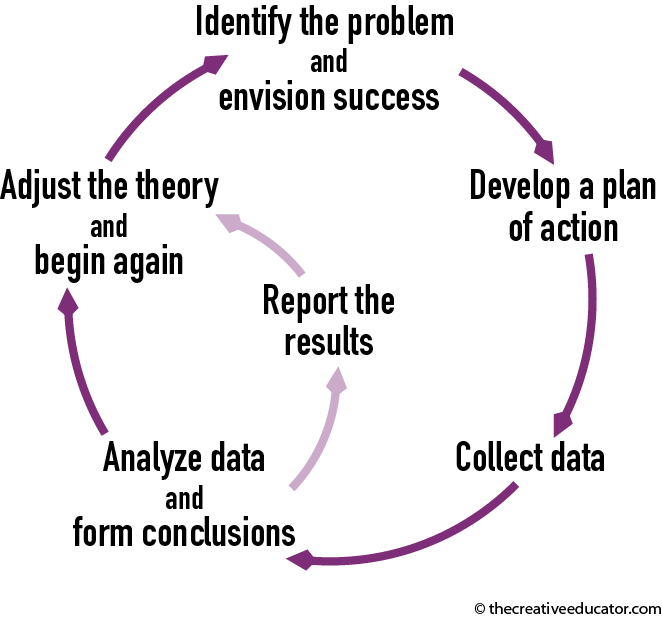
Improve classroom practice with action research ... and tell the story

The action research process can help you understand what is happening in your classroom and identify changes that improve teaching and learning. Action research can help answer questions you have about the effectiveness of specific instructional strategies, the performance of specific students, and classroom management techniques.
Educational research often seems removed from the realities of the classroom. For many classroom educators, formal experimental research, including the use of a control group, seems to contradict the mandate to improve learning for all students. Even quasi-experimental research with no control group seems difficult to implement, given the variety of learners and diverse learning needs present in every classroom.
Action research gives you the benefits of research in the classroom without these obstacles. Believe it or not, you are probably doing some form of research already. Every time you change a lesson plan or try a new approach with your students, you are engaged in trying to figure out what works. Even though you may not acknowledge it as formal research, you are still investigating, implementing, reflecting, and refining your approach.
Qualitative research acknowledges the complexity of the classroom learning environment. While quantitative research can help us see that improvements or declines have occurred, it does not help us identify the causes of those improvements or declines. Action research provides qualitative data you can use to adjust your curriculum content, delivery, and instructional practices to improve student learning. Action research helps you implement informed change!
The term “action research” was coined by Kurt Lewin in 1944 to describe a process of investigation and inquiry that occurs as action is taken to solve a problem. Today we use the term to describe a practice of reflective inquiry undertaken with the goal of improving understanding and practice. You might consider “action” to refer to the change you are trying to implement and “research” to refer to your improved understanding of the learning environment.
Action research also helps you take charge of your personal professional development. As you reflect on your own actions and observe other master teachers, you will identify the skills and strategies you would like to add to your own professional toolbox. As you research potential solutions and are exposed to new ideas, you will identify the skills, management, and instructional training needed to make the changes you want to see.

Action research is a cycle of inquiry and reflection. During the process, you will determine 1) where you are, 2) where you want to be, and 3) how you are going to get there. In general terms, the cycle follows these steps:
The process begins when you identify a question or problem you want to address. Action research is most successful when you have a personal investment, so make sure the questions you are asking are ones YOU want to solve. This could be an improvement you want to see happen in your classroom (or your school if you are a principal), or a problem you and your colleagues would like to address in your district.
Learning to develop the right questions takes time. Your ability to identify these key questions will improve with each iteration of the research cycle. You want to select a question that isn’t so broad it is almost impossible to answer or so narrow that the only answer is yes or no. Choose questions that can be answered within the context of your daily teaching. In other words, choose a question that is both answerable and worthy of the time investment required to learn the answer.
Questions you could ask might involve management issues, curriculum implementation, instructional strategies, or specific student performance. For example, you might consider:
Determining the question helps focus your inquiry.
Before you can start collecting data, you need to have a clear vision of what success looks like. Start by brainstorming words that describe the change you want to see. What strategies do you already know that might help you get there? Which of these ideas do you think might work better than what you are currently doing?
To find out if a new instructional strategy is worth trying, conduct a review of literature. This doesn’t have to mean writing up a formal lit review like you did in graduate school. The important thing is to explore a range of articles and reports on your topic and capitalize on the research and experience of others. Your classroom responsibilities are already many and may be overwhelming. A review of literature can help you identify useful strategies and locate information that helps you justify your action plan.
The Web makes literature reviews easier to accomplish than ever before. Even if the full text of an article, research paper, or abstract is not available online, you will be able to find citations to help you locate the source materials at your local library. Collect as much information on your problem as you can find. As you explore the existing literature, you will certainly find solutions and strategies that others have implemented to solve this problem. You may want to create a visual map or a table of your problems and target performances with a list of potential solutions and supporting citations in the middle.
Now that you have identified the problem, described your vision of how to successfully solve it, and reviewed the pertinent literature, you need to develop a plan of action. What is it that you intend to DO? Brainstorming and reviewing the literature should have provided you with ideas for new techniques and strategies you think will produce better results. Refer back to your visual map or table and color-code or reorder your potential solutions. You will want to rank them in order of importance and indicate the amount of time you will need to spend on these strategies.
How can you implement these techniques? How will you? Translate these solutions into concrete steps you can and will take in your classroom. Write a description of how you will implement each idea and the time you will take to do it.
Once you have a clear vision of a potential solution to the problem, explore factors you think might be keeping you and your students from your vision of success. Recognize and accept those factors you do not have the power to change–they are the constants in your equation. Focus your attention on the variables–the parts of the formula you believe your actions can impact.
Develop a plan that shows how you will implement your solution and how your behavior, management style, and instruction will address each of the variables. Sometimes an action research cycle simply helps you identify variables you weren’t even aware of, so you can better address your problem during the next cycle!
Before you begin to implement your plan of action, you need to determine what data will help you understand if your plan succeeds, and how you will collect that data. Your target performances will help you determine what you want to achieve. What results or other indicators will help you know if you achieved it? For example, if your goal is improved attendance, data can easily be collected from your attendance records. If the goal is increased time on task, the data may include classroom and student observations.
There are many options for collecting data. Choosing the best methodologies for collecting information will result in more accurate, meaningful, and reliable data.
Obvious sources of data include observation and interviews. As you observe, you will want to type or write notes or dictate your observations into a cell phone, iPod, or PDA. You may want to keep a journal during the process, or even create a blog or wiki to practice your technology skills as you collect data.
Reflective journals are often used as a source of data for action research. You can also collect meaningful data from other records you deal with daily, including attendance logs, grade reports, and student portfolios. You could distribute questionnaires, watch videotapes of your classroom, and administer surveys. Examples of student work are also performances you can evaluate to see if your goal is being met.
Create a plan for data collection and follow it as you perform your research. If you are going to interview students or other teachers, how many times will you do it? At what times during the day? How will you ensure your respondents are representative of the student population you are studying, including gender, ability level, experience, and expertise?
Your plan will help you ensure that you have collected data from many different sources. Each source of data provides additional information that will help you answer the questions in your research plan.
You may also want to have students collect data on their own learning. Not only does this provide you with additional research assistants, it empowers students to take control of their own learning. As students keep a journal during the process, they are also reflecting on the learning environment and their own learning process.

The next step in the process is to analyze your data and form conclusions. Start early! Examining the data during the collection process can help you refine your action plan. Is the data you are collecting sufficient? If not, you have an opportunity to revise your data collection plan. Your analysis of the data will also help you identify attitudes and performances to look for during subsequent observations.
Analyzing the data also helps you reflect on what actually happened. Did you achieve the outcomes you were hoping for? Where you able to carry out your actions as planned? Were any of your assumptions about the problem incorrect?
Adding data such as opinions, attitudes, and grades to tables can help you identify trends (relationships and correlations). For example, if you are completing action research to determine if project-based learning is impacting student motivation, graphing attendance and disruptive behavior incidents may help you answer the question. A graph that shows an increase in attendance and a decrease in the number of disruptive incidents over the implementation period would lead you to believe that motivation was improved.
Draw tentative conclusions from your analysis. Since the goal of action research is positive change, you want to try to identify specific behaviors that move you closer to your vision of success. That way you can adjust your actions to better achieve your goal of improved student learning.
Action research is an iterative process. The data you collect and your analysis of it will affect how you approach the problem and implement your action plan during the next cycle.
Even as you begin drawing conclusions, continue collecting data. This will help you confirm your conclusions or revise them in light of new information. While you can plan how long and often you will collect data, you may also want to continue collecting until the trends have been identified and new data becomes redundant.
As you are analyzing your data and drawing conclusions, share your findings. Discussing your results with another teacher can often yield valuable feedback. You might also share your findings with your students who can also add additional insight. If they agree with your conclusions, you have added credibility to your data collection plan and analysis. If they disagree, you will know to reevaluate your conclusions or refine your data collection plan.
Now that you have formed a final conclusion, the cycle begins again. In light of your findings, you should have adjusted your theory or made it more specific. Modify your plan of action, begin collecting data again, or begin asking new questions!
While the ultimate goal of your research is to promote effective change in your classroom or schools, do not underestimate the value of sharing your findings with others. Sharing your results helps you further reflect on the process and problem, and it allows others to use your results to help them in their own endeavors to improve the education of their students.
You can report your findings in many different ways. You most certainly will want to share the experience with your students, parents, teachers, and principal. Provide them with an overview of the process and share highlights from your research journal. Because each of these audiences is different, you will need to adjust the content and delivery of the information each time you share. You may also want to present your process at a conference so educators from other districts can benefit from your work.
As your skill with the action research cycle gets stronger, you may want to develop an abstract and submit an article to an educational journal. To write an abstract, state the problem you were trying to solve, describe your context, detail your action plan and methods, summarize your findings, state your conclusions, and explain your revised action plan.
If your question focused on the implementation of an action plan to improve the performance of a particular student, what better way to show the process and results than through digital storytelling? Using a tool like Wixie, you can share images, audio, artifacts and more to show the student’s journey. Action research is outside-the-box thinking… so find similarly unique ways to report your findings!
All teachers want to reach their students more effectively and help them become better learners and citizens. Action research provides a reflective process you can use to implement changes in your classroom and determine if those changes result in the desired outcome.
Your ideas and experience combined with action research are a powerful formula for effective change!
Grady, M.P. (1998). Qualitative and Action Research. Bloomington: Phi Delta Kappa Educational Foundation.
Sagor, R. (2005). The Action Research Handbook. Thousand Oaks: Corwin Press.

Follow us on Instagram for daily inspiration

Create a thought web, cluster, flowchart, or other graphic organizer for a lesson
Five ideas for creative classroom centers
Creative, digital book reviews
Fun and powerful ideas with animated characters

Wixie
Share your ideas, imagination, and understanding through writing, art, voice, and video.

Rubric Maker
Create custom rubrics for your classroom.

Pics4Learning
A curated, copyright-friendly image library that is safe and free for education.

Wriddle
Write, record, and illustrate a sentence.

Get creative classroom ideas delivered straight to your inbox once a month.
Topics